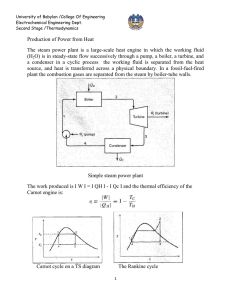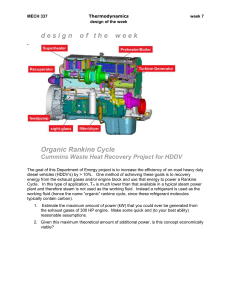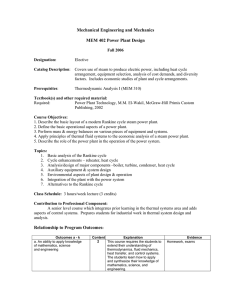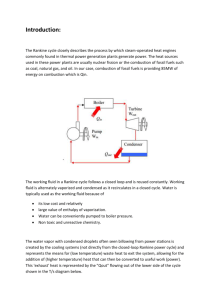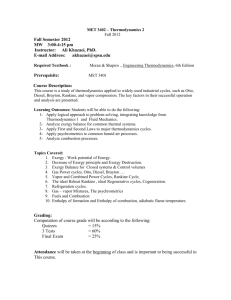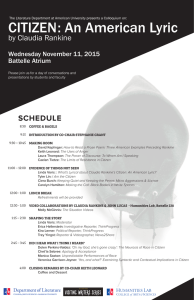Technical Objectives: Explain fossil fuel, nuclear, solar or other thermal source.
advertisement
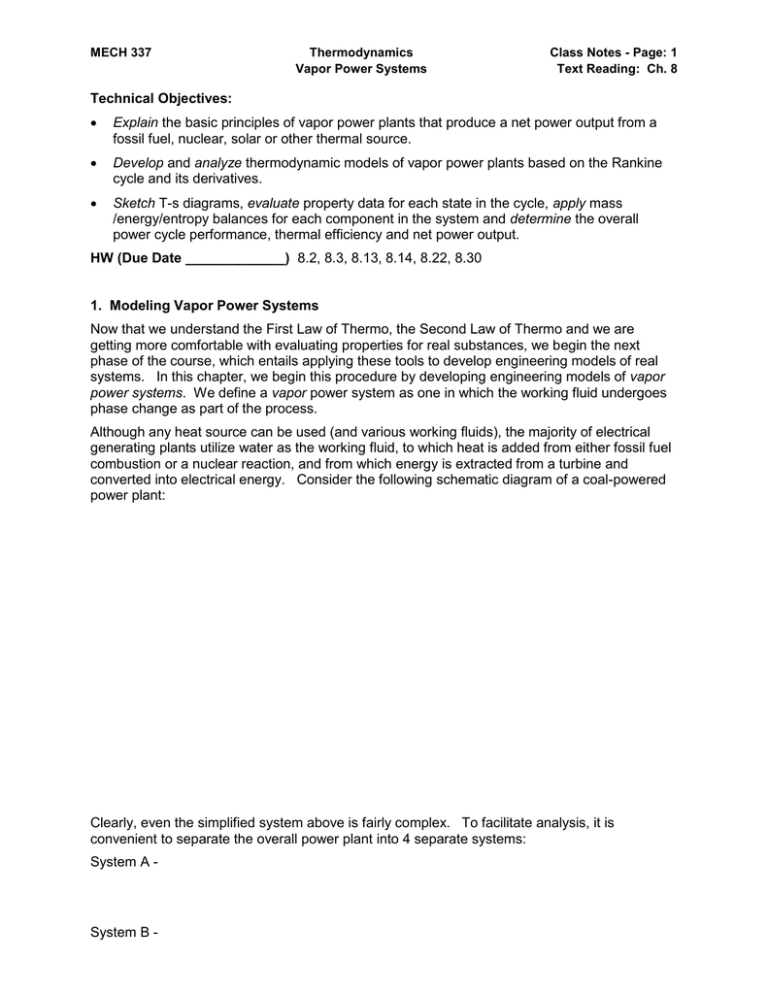
MECH 337 Thermodynamics Vapor Power Systems Class Notes - Page: 1 Text Reading: Ch. 8 Technical Objectives: Explain the basic principles of vapor power plants that produce a net power output from a fossil fuel, nuclear, solar or other thermal source. Develop and analyze thermodynamic models of vapor power plants based on the Rankine cycle and its derivatives. Sketch T-s diagrams, evaluate property data for each state in the cycle, apply mass /energy/entropy balances for each component in the system and determine the overall power cycle performance, thermal efficiency and net power output. HW (Due Date _____________) 8.2, 8.3, 8.13, 8.14, 8.22, 8.30 1. Modeling Vapor Power Systems Now that we understand the First Law of Thermo, the Second Law of Thermo and we are getting more comfortable with evaluating properties for real substances, we begin the next phase of the course, which entails applying these tools to develop engineering models of real systems. In this chapter, we begin this procedure by developing engineering models of vapor power systems. We define a vapor power system as one in which the working fluid undergoes phase change as part of the process. Although any heat source can be used (and various working fluids), the majority of electrical generating plants utilize water as the working fluid, to which heat is added from either fossil fuel combustion or a nuclear reaction, and from which energy is extracted from a turbine and converted into electrical energy. Consider the following schematic diagram of a coal-powered power plant: Clearly, even the simplified system above is fairly complex. To facilitate analysis, it is convenient to separate the overall power plant into 4 separate systems: System A - System B - MECH 337 Thermodynamics Vapor Power Systems Class Notes - Page: 2 Text Reading: Ch. 8 System C – System D - This chapter will focus specifically on analyzing system A, wherein energy is converted from heat to work. 2. Analyzing Vapor Power Systems – The Rankine Cycle Returning to System A, we can now analyze the system from the first and second law principles that we have developed in previous chapters. Redrawing the system here: The overall system is a closed system, which undergoes a power cycle. Therefore, the principles of the First and Second Law for a closed system must apply. Specifically, for the overall system: (8.5) and Next, we can analyze each of the 4 sub-systems in System A (turbine, condenser, pump and boiler) using first law analysis for control volumes at steady state. 2.1 Turbine (8.1) MECH 337 Thermodynamics Vapor Power Systems Class Notes - Page: 3 Text Reading: Ch. 8 2.2 Condenser t as the magnitude of the rate of heat transfer from the working fluid (positive in Defining Q out / m the direction shown above): (8.2) 2.3 Pump as the rate of power input to the pump (positive in the direction shown above): Defining W p / m (8.3) 2.4 Boiler (8.4) 2.5. Performance Parameters for the Overall System Having analyzed the 4 subsystems using the First Law for open systems, we can now return to the overall System A to calculate the overall performance of the system. The overall thermal efficiency of the system can be calculated as follows: (8.5a) MECH 337 Thermodynamics Vapor Power Systems Class Notes - Page: 4 Text Reading: Ch. 8 Recognizing, however that the net work of the cycle must be equal to the net heat input of the cycle, equation (8.5a) can also be expressed as: (8.5b) The back work ratio is defined as the ratio of the power input required to operate the pump, divided by the power output of the turbine: (8.6) 3. The Ideal Rankine Cycle In reality each of the above subsystems have internal irreversibilities, such as: However, although irreversibilities exist in each of the above subsystem components, the first step in the design of a real vapor power system is to determine the maximum possible efficiency of the Ideal Rankine Cycle, in which each component is performing to its maximum theoretical 2nd law efficiency. Specifically, the Ideal Rankine Cycle is as follows: Process 1-2 Process 2-3 Process 3-4 Process 4-1 MECH 337 Thermodynamics Vapor Power Systems Class Notes - Page: 5 Text Reading: Ch. 8 Note the ideal Rankine Cycle plotted above assumed that state 1 was a saturated vapor. The ideal Rankine Cycle can also start with a superheated vapor as shown below: We call this cycle the Ideal Rankine Cycle with Superheat. Example 8.1 Ideal Rankine Cycle Known: Steam is used as the working fluid for an ideal Rankine Cycle with a boiler pressure of 8 MPa and a condenser pressure of 0.008 MPa. The net power developed by the system is 100 MW. Find: a) The thermal efficiency, b) the required mass flow rate [kg/s], c) the rate of heat transfer into the boiler [MW], d) the rate of heat transfer out of the condenser [MW] and e) compare the thermal efficiency for the ideal Rankine Cycle to the maximum achievable efficiency obtainable between Tcond and Tboil. Schematic Diagram and Given Data: Engineering Model: Analysis: MECH 337 Thermodynamics Vapor Power Systems Class Notes - Page: 6 Text Reading: Ch. 8 MECH 337 Thermodynamics Vapor Power Systems Class Notes - Page: 7 Text Reading: Ch. 8 3.1 Effects of Boiler and Condenser Pressures on Performance of Ideal Rankine Cycle Recall from Chapter 5 that the overall efficiency of any power cycle increases as the ratio of the temperature of the hot reservoir to that of the cold reservoir increases. Indeed, the maximum efficiency can be calculated as: (5.9) As example 8.1 showed, the thermal efficiency of the ideal Rankine Cycle is not identical to the maximum achievable efficiency obtainable by operating a cycle between the boiler temperature and the condenser temperature, respectively. However, the same trends should be observed. Specifically, the efficiency of the ideal Rankine Cycle should increase with increasing boiler temperature and/or decreasing condenser temperature. Consider again the T-s diagram for the Ideal Rankine Cycle: Assuming that the heat transfer in the boiler is internally reversible, then the heat transfer to the working fluid in the boiler can be evaluated as follows: Similarly, the heat transfer from the working fluid in the condenser can be evaluated as: The thermal efficiency can then be evaluated from (8.5b) and approximated as: (8.5b) MECH 337 Thermodynamics Vapor Power Systems Class Notes - Page: 8 Text Reading: Ch. 8 (8.8) Where, for the ideal cycle, s1= s2 and s3 = s4. Equation 8.8 shows that increasing boiler pressure, which in turn, increases Tin results in increased efficiency of the ideal Rankine cycle. Similarly, equation (8.8) also shows that decreased condenser pressure will also increase the efficiency. 3.2 Comparison between the Ideal Rankine Cycle and the Carnot Cycle Although equation (8.8) shows that the ideal Rankine Cycle efficiency varies in the same manner as the Carnot Efficiency, Example 8.1 showed that the Ideal Rankine Cycle efficiency does not equal the Carnot Efficiency. Why not? Consider the difference between the Carnot Cycle and the Ideal Rankine Cycle operating between the same boiler and condenser pressures, with saturation temperatures of TH and TC respectively: For the Carnot Cycle, the efficiency is as follows: For the Ideal Rankine Cycle, operating between the same boiler and condenser pressures, the efficiency was shown to be equal to: (8.8) Clearly, since Tin < TH, the efficiency of the Rankine Cycle must be less than the Carnot Cycle. So, why don’t we use the Carnot Cycle in steam power plants? MECH 337 Thermodynamics Vapor Power Systems Class Notes - Page: 9 Text Reading: Ch. 8 3.3 Irreversibilities and Losses in Real Rankine Cycle Operation Each of the four subsystems have losses and irreversibilities that result in decreased performance of a Real Rankine Cycle as compared to the ideal Rankine Cycle. The major losses are related to entropy production in the turbine and the pump due to friction. In addition, there is pressure drop in the boiler and condenser. An actual Rankine Cycle is shown on the Ts diagram below: As discussed in Chapter 6, we account for the irreversibilities in the turbine and pump by introducing isentropic efficiencies for each of these devices according to the following equations: (8.9) (8.10) Example 8.2 Non-Ideal Rankine Cycle Known: Steam is used as the working fluid for an ideal Rankine Cycle with a boiler pressure of 8 MPa and a condenser pressure of 0.008 MPa. The net power developed by the system is 100 MW. The isentropic turbine and pump efficiencies are 85%. The pressure drop in the condenser and boiler is assumed to be negligible. Find: a) The thermal efficiency, b) the required mass flow rate [kg/s], c) the rate of heat transfer into the boiler [MW], d) the rate of heat transfer out of the condenser [MW] and e) compare the thermal efficiency for the Non-Ideal Rankine Cycle to that of the Ideal Rankine Cycle and the Carnot Cycle operating between the same Tcond and Tboil. Schematic Diagram and Given Data: MECH 337 Engineering Model: Analysis: Thermodynamics Vapor Power Systems Class Notes - Page: 10 Text Reading: Ch. 8 MECH 337 Thermodynamics Vapor Power Systems Class Notes - Page: 11 Text Reading: Ch. 8 4. Superheat and Reheat Cycles The Rankine Cycle as discussed thus far assumes that the working fluid is a saturated vapor at the inlet to the turbine. We also learned that increased boiler pressure results in increased efficiency of the cycle: A major practical constraint, however, is that liquid droplets in the liquid-vapor mixture within the turbine can cause excessive wear on the turbine blades. Accordingly, it is common practice to maintain a quality of x > 90% at the turbine exit. As shown from the diagram above, as boiler pressure increases, the quality of the mixture exiting the turbine decreases. There are several ways to alleviate this problem: superheat and reheat. 4.1 Rankine Cycle with Superheat One simple way to increase efficiency and ensure high quality steam at the turbine exit is to continue to add heat to the working fluid in a superheater, which is a separate heat exchanger downstream of the boiler. The superheater produces a superheated vapor at the inlet to the turbine: As you can see from the figure above, the Rankine Cycle with superheat would have a higher efficiency than a similar cycle that operated at the same boiler temperature, but did not employ superheat. Moreover, the quality at the exit of the turbine is much higher. MECH 337 Thermodynamics Vapor Power Systems Class Notes - Page: 12 Text Reading: Ch. 8 4.2 Rankine Cycle with Reheat The Rankine Cycle with Superheat is limited by the pressure at which you can operate the boiler/superheater and maximum allowable inlet temperature of the turbine. Another way to ensure high quality steam at the turbine exit is to employ a multi-stage turbine and reheat the steam after each stage of the turbine: 5. Organic Rankine Cycle for Waste Heat Recovery Because of the size and scale of most electrical power generating plants, steam is the preferred working fluid. However, there is much recent interest in systems that generate power from lower temperature heat sources such as the waste heat from exhaust gases of an engine, etc. For these applications, working fluids other than steam are preferable. Most applications use hydrocarbon (i.e. organic) refrigerants as working fluids. Consider that a typical internal combustion engine has an overall efficiency of approximately 33%. This means that 67% of the total energy available in the fuel is wasted. The majority of the energy is lost in the thermal energy of the exhaust gases and cooling water. In theory, some of this energy could be recovered by employing an Organic Rankine Cycle: How would you evaluate the efficiency of such a cycle?
